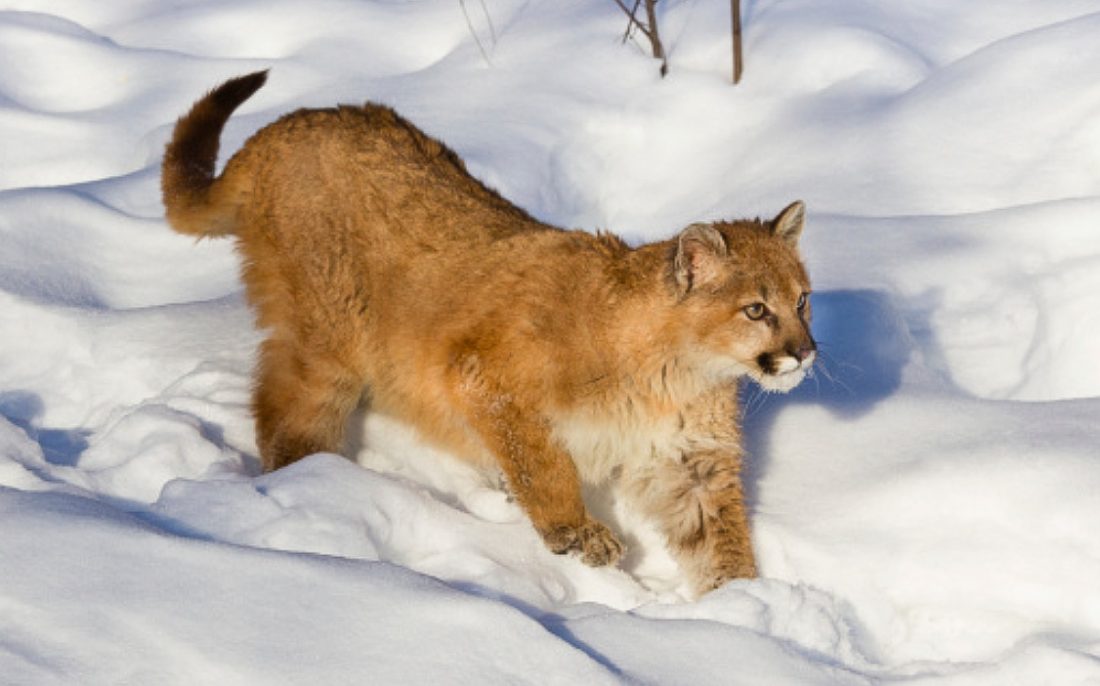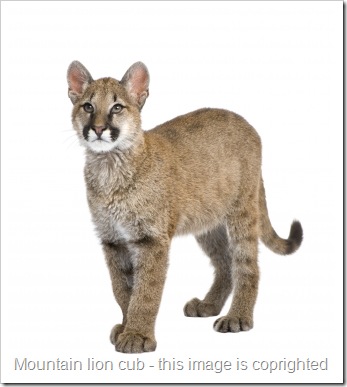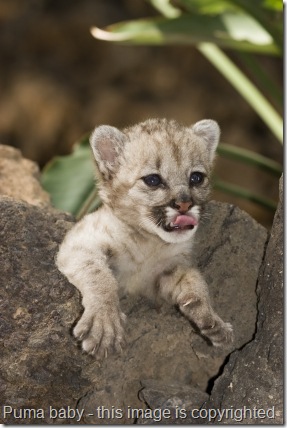In talking about mountain lion cubs were are talking about beauty, vulnerability, and parenting. I cover these topics but first a picture and a video of a cub and a baby to illustrate the page. In academic terminology this page is about reproduction and development in respect of the puma (another name for the mountain lion).

So, what is it like for mountain lion cubs? What are the stages to becoming independent?
A newborn kitten weighs between about 400 and 500 grams (just over a pound). The fur is brownish and densely spotted. Thereafter this is the timetable:
| Mountain lion age | Event |
| day 5 and 14 | eyes are blue |
| 2 weeks | eyes are open and kitten is playing and begin to walk |
| 7 to 8 weeks | kittens are fairly agile. Kittens nurse until about 8 weeks of age. Rarely the mother brings back meat to kittens |
| 6 months | kittens start to travel and begin to hunt with their mother (estimated that this takes place 19% of the time |
| 8 months | markings become faded and eyes start to change colour. Canine teeth have grown. This is about the minimum age at which a puma has survived on his/her own (due to mother being killed) |
| ten months | markings difficult to see |
| About 12 months – 1 year | Mountain lion cubs are independent. Research indicates independence arrives between 10 months and 21 months |
| 1 year + (14 to 21 months on average – some females stay in the natal area or near it as do a lower percentage of males). | independence of mountain lion cubs is followed by dispersal (moving away from the “natal area” – the area where they were born). This varies with the area and probably depends on vacant ranges, population density, quality of habitat, hunt pressure and kitten mortality |
| 16 months | eyes are yellow brown as per an adult |
| After dispersal and puma is independent | pumas travelled as far as about 85 to 100 kilometres from the natal area on independence and dispersal and sometimes further. Males go further than females (females 40 k from natal area) |
| Resident males (those who have established ranges) can kill newcomers both male and female | |
| 19 to 20 years – in captivity | puma dies |
| Males: average 6.5+ years and females: 7.5 years in the wild – Washington state | puma dies |
RELATED: Mountain lion tracks – detailed discussion and video
Mortality can be high for newly independent mountain lions who are looking for a range as residents will kill. This is a high-risk time for the young puma.
| Area | Event – % pumas killed on becoming independent |
| California | 2/9th (22%) survived to establish their own range the remainder killed by sport hunting and/or traffic |
| Western Colorado | 2/12th (17%) survived the remainder being killed |
When mountain lion cubs learn to hunt, they walk slowly and scan either side of the trail. The cubs recognise prey by (a) its movement (b) the scent trails left by prey (c) the sound of the prey (d) and their experience in having eaten a certain kind of prey before provided by the mother. At about six months of age young mountain lions start to hunt with their mother but they don’t accompany her all the time. In fact, in Utah, a study found that cubs less than seven months old were with their mother about 19% of the time.
This is a time of great stress from a feeding standpoint for the mother because she has to increase the number of kills but she has the interference of a young to deal with. And of course, as her cubs grow in size they eat more – see the chart below.
I cannot leave this task without referring to the mother’s role in birthing and rearing her young offspring.

RELATED: Conservation of the puma a.k.a. mountain lion – full discussion 2022
The Mother’s Role
The mother is receptive (on heat – estrus, estrous or oestrus) to the attentions of the male puma for a period of 4 to 1 2days (captive puma research). Male and female typically stay together for 1-4 days when breeding. The oestrus cycle is between 23 and 60 days (captive) and 3-4 weeks (form wild cat research). The oestrus cycle is: the periodic changes in the female that take place under the influence of the sex hormones.
The age at which female pumas become sexually active (first reproduction) varies and can be 18 months to 43 months of age. The variation is thought to be dependent on acquiring a home range.
Pumas behave in a similar way to other cats when mating (see cats mating). The female solicits the male by provocative behaviour followed by body rubbing and calling. It is believed that ovulation (the production of the egg – ovum) is induced by the mating (as opposed to happening periodically).
Gestation (the time of the pregnancy) lasts 92 to 93 days. Litters are typically 1-6 kittens. Birth takes place in a den, which is well hidden (e.g. caves or roots of a tree). The availability of food probably dictates when births take place. After all the mother has to find prey more frequently than normal.
As mentioned above when the mountain lion cubs are about 6 months of age they accompany their mother on hunting expeditions. At this stage the mother is under pressure to provide for her young by increasing hunting trips – see below.
| Situation | Intervals between kills |
| Female on her own | One mule deer every 16 days to sustain herself |
| Mother + 3 kittens each of 3 months of age | One mule deer every 9 days |
| Mother + 3 cubs of 15 months of age | One mule deer every 3 days. |
It is probably that breeding populations of pumas only exist where there is sufficient prey. I am once again indebted to Mel and Fiona Sunquist the authors of Wild Cats of the World for the main source material together with Stockxpert (pictures) and YouTube.
![]()



